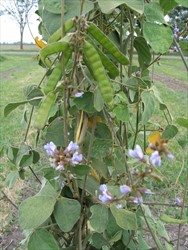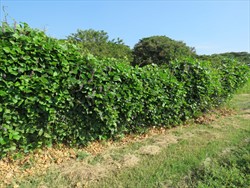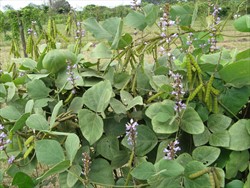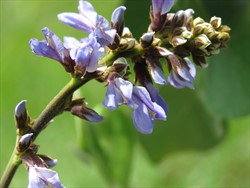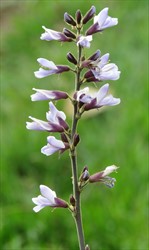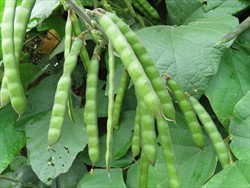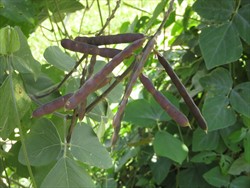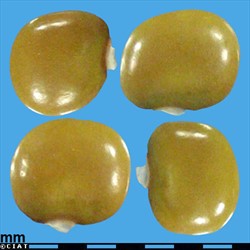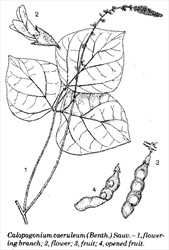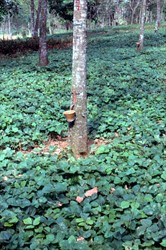Tropical Forages
Basionym: Stenolobium caeruleum Benth.
Family: Fabaceae (alt. Leguminosae) subfamily: Faboideae tribe: Phaseoleae subtribe: Glycininae.
A twining, perennial legume, with stems up to several metres long, becoming woody with age, rooting at nodes when in contact with moist soil; may be hairy or nearly hairless. Leaves trifoliolate with a long petiole (to 16 cm); leaflets elliptical, ovate or rhomboid ovate, 6‒9 cm × 4‒6 cm. Lateral leaflets are oblique and pubescent above, velvety pubescent below. The inflorescence is an elongated raceme, up to 50 cm long with many flowers consisting of a bell-shaped, 5-lobed calyx and blue or violet corolla, about 1 cm long. The rachis is furrowed and covered with short hairs. Pod linear-oblong, 4‒8 cm × 0.8 cm, straight or curved, beaked, impressed between the seeds, pubescent. Seeds are shiny-brown in colour, 4‒5 mm across, orbiculate in shape; 4‒8 seeds/pod. 20,000–50,000 seeds/kg.
Similar species
C. caeruleum: Stems, petioles, calyces and pods densely reddish-brown tomentose, the trichomes not individually visible, inflorescences usually >20 cm long; pods 4–8 cm long, 8 mm wide.
C. mucunoides: Stems, petioles, calyces and pods sparsely long-hispid, the trichomes to c. 2 mm long; inflorescences <15 cm long; pods 2–4 cm long, 3.5‒5mm wide.
Asia: thua sealulium (Thailand)
English: caeruleum (= sky blue) calopo; jicama (USA)
Latin America: ahorca perro, bejuco culebra, bejuco de lavar, caraotillo, choreque, falso pica-pica, frijol boniato, frijolillo, haba de burro, jícama cimarrona, jíquima, klein kau, mata potrero, namie napirang (Spanish); catinga do macaco, feijão-bravo, feijão-de-macaco, feijãozinho-da-mata (Brazil)
Native:
Northern America: Mexico (Chiapas, Colima, Guerrero, Jalisco, Mexico, Michoacán, Nayarit, Oaxaca, Puebla, Querétaro, San Luis Potosí, Tabasco, Veracruz, Yucatán)
Caribbean: Cuba, Hispaniola, Puerto Rico, St. Vincent and Grenadines (St. Vincent), Trinidad and Tobago
Central America: Belize, Costa Rica, El Salvador, Guatemala, Honduras, Nicaragua, Panama
South America: Argentina (Misiones), Brazil, Colombia, Ecuador, French Guiana, Guyana, Paraguay, Suriname, Peru, Venezuela
Cultivated/naturalized:
Throughout the humid tropics
Forage
C. caeruleum has little or no appication as a forage due to its low palatability.
Environment
Green manure crop providing large amounts of dry matter through leaf fall. Cover crop, especially in tropical tree plantations (in SE Asia, often in a mix with other legume species). It forms a dense cover even under trees protecting the soil from erosion, improving soil fertility, and smothering weeds, thereby reducing the need for herbicides.
Soil requirements
Adapted to a wide range of soil textures and soils with pH as low as 4.0. Grows best on well-drained soils. Despite its tolerance of low pH, responds to P fertilizer and lime on acid infertile soils.
Moisture
Adapted to the humid tropics with annual rainfall of 1,000‒3,000 mm, but will persist in environments with as low as 700 mm rainfall. More drought tolerant than and Neustanthus phaseoloides.
Temperature
Prefers tropical environments with 25 ºC maximum and 18 ºC minimum day temperatures, with outer limits of 32 ºC maximum and 10 ºC minimum. Will outperform and Centrosema molle in cool conditions.
Light
Productivity is relatively constant at 60‒100% light transmission. Will grow productively in mature coconut plantations (60‒70% PAR), and is tolerant of heavy shade.
Reproductive development
In the humid tropics, flowers indeterminately through the first wet season, producing seed into the dry season. Capable of producing moderate amounts of seed in the establishment year.
Defoliation
Rarely grazed by cattle and may dominate pastures unless controlled.
Fire
No information available.
Guidelines for establishment and management of sown forages.
Establishment
Usually established from seed, sowing into a cultivated seedbed at the beginning of the wet season. Establishment can be slow and may be improved by addition of P Fertilizer and lime, and by controlling weeds. Current recommendations for cover crop under oil palm in southeast Asia are to seed and Neustanthus phaseoloides at 1‒1.5 and 5‒7.5 kg seed/ha, respectively. Can be established by stem cuttings but low success rates (5% of cuttings) are common. Using older stem material and treating stems with root-promoting hormones can improve success rates. Slower to establish than and N. phaseoloides and may take 20 months to achieve a complete cover. As a green manure crop, can be established by broadcasting into upland rice following the final weeding. Mid-season plantings may reduce rice yields.
Fertilizer
Despite its acid soil tolerance, best growth of on an acid, infertile soil in Indonesia was achieved with application of 10.8 t lime/ha and 315 kg triple superphosphate/ha. The critical levels of Al saturation and available P (Olsen) of the soil for were 6.8% and 7 ppm P, respectively. Growth declined at higher Al saturation percentage and lower P concentration.
Compatibility (with other species)
Companion grasses are grazed in preference to , resulting in the dominance of this unpalatable legume.
In species mixtures, eventually dominates, especially under heavy shade, along with Grona heterocarpa ssp. ovalifolium.
Companion species
Legumes: Planted as a cover crop in southeast Asian plantation agriculture, often in a mixture with one or more of the species , Centrosema molle, Neustanthus phaseoloides and Grona heterocarpa subsp. ovalifolia.
Pests and diseases
The fungal pathogens Cercospora leafspot, anthracnose and Rhizoctonia foliar blight have been identified on in Colombia.
Ability to spread
Will spread from stolons under favourable conditions, rooting at the nodes.
Weed potential
Can become a weed and has invaded seasonally wet tropical environments.
Nutritive value
Top growth has moderate to high nutritive value and contains 13‒23% CP. In Nigeria, 6-month regrowth had in sacco DMD of 48‒55%, CP 13‒16%, Ca 2.0‒2.25%, P 0.2‒0.3%; dry-season values were somewhat lower. In Colombia, leaf material of 6 months old plants contained 18% CP, 1.15% Ca, 0.20% P, 49% IVDMD and no condensed tannins.
Palatability/acceptability
Very low palatability to ruminant livestock. Over an 8-month period of grazing by sheep in a rubber plantation in Malaysia, Paspalum conjugatum and other forages rapidly decreased in contribution to DM as they were grazed in preference to which increased its contribution from 5 to 40%. Palatability improves to a limited extent during the dry season, although intake generally remains extremely low. There may be potential to select for improved palatability from within the available germplasm collection. Ensiling may improve palatability.
Toxicity
Appears not to contain compounds toxic to livestock.
Feedipedia link
Dry matter
One of the most productive herbaceous legumes, generally producing yields of 3‒7 t DM/ha/year. Produced DM yields of 1‒1.5 t/ha/year under mature oil palm (10% light transmission), out-yielding a wide range of common herbaceous legumes. As a green manure crop/mulch, leaf fall from uncut can be as high as 7 t DM/ha/year. In Nigeria, it had the second highest green manure effect on maize yield among 12 legumes tested, providing an N equivalent of about 90 kg/ha.
Animal production
Sheep grazing pastures dominated by under 7-year-old mature rubber at Selangor, Malaysia, gained 99 g liveweight/head/day at a stocking rate of 2 sheep/ha (72 kg/ha/year). The forage availability was <0.6 t/ha. Under immature rubber, early high levels of forage production (2.2 t/ha) supported liveweight gain of 84 g /head/day at a stocking rate of 14 sheep/ha (429 kg/ha per year). Grazing decreased the proportion of palatable species and increased the proportion of from 5 to 40%.
Cattle grazing open guinea grass (Megathyrsus maximus)- pastures gained 500 g/head/day over the first 2 years of grazing, but liveweight gains declined to 200 g/head/day as the legume became dominant over the subsequent year.
No breeding programmes are currently being conducted. In field and pot experiments in Colombia, most accessions showed poor adaptation to acid infertile soils and drought, and had problems with diseases, pests and acceptance by cattle. A few accessions, however, showed promise, indicating agronomic and forage quality variation within the species.
Produces seed in the first year of growth. In southern Thailand, seed production was increased by basal fertilizer application of monocalcium phosphate, gypsum, potassium sulphate, magnesium, zinc, copper, cobalt and molybdenum at the rates of 205, 40, 330, 60, 14, 4, 0.6 and 1.2 kg/ha, respectively. Seed yield increase was attributed to improved plant survival and increased number of pods per plant.
A range of herbicides applied at a spray volume of 400 L/ha was evaluated for control of weeds during the establishment of sown 3‒4 cm deep as a cover crop. Oxyfluorfen at 0.3 kg/ha applied in the rows immediately after sowing caused some initial injury but the effect was short-lived. No damage occurred with the herbicides diphenamid at 3 kg/ha, neburon at 2 kg/ha, napropamide at 2 kg/ha, alachlor at 0.5‒1 kg/ha and metolachlor at 2 kg/ha. In a separate experiment, imazethapyr at 15‒400 g ai/ha provided excellent control of weeds and facilitated rapid establishment of Neustanthus phaseoloides and in oil palm plantations.
Poor control of (as a weed) was achieved when mature plants were sprayed with metsulfuron at 10 g/ha and 20 g/ha, glyphosate at 10 g/ha and 20 g/ha, paraquat at 560 g/ha and diuron + paraquat at 560 + 560 g/ha. However, combinations of metsulfuron + glyphosate or paraquat at 10 + 560 g and 20 + 560 g achieved effective control 4 weeks after application.
Fosamine at 0.75‒1 kg ai/ha provided excellent suppression of for 8‒12 weeks to reduce competition in planting sites for rubber and oil palm. Efficacy depended on the vigour of the plants at the time of spraying.
- High DM production.
- Excellent cover crop in humid-tropical tree plantations.
- One of the most shade tolerant tropical legumes.
- Essentially unpalatable to grazing livestock.
- Slow to establish.
- Weed potential.
Chen, C.P. and Chee, Y.K. (1992) Calopogonium caeruleum. In: Mannetje, L.’t and Jones, R.M. (eds) Plant Resources of South-East Asia No. 4. Forages. Pudoc Scientific Publishers, Wageningen, the Netherlands. p. 71–72. edepot.wur.nl/327785
Chong, D.T., Tajuddin, I., Samat, A.M.S., Stür, W.W. and Shelton, H.M. (1997) Stocking rate effects on sheep and forage productivity under rubber in Malaysia. Journal of Agricultural Science 128:339–346. doi.org/10.1017/S0021859696004236
Hardjono, A. and Warsito, T. (1990) The effect of lime and P fertilizer on the growth of Calopogonium caeruleum. II. Field experiment. Menara Perkebunan 58:70–73.
Middleton, C.H. and Mellor, W. (1982) Grazing assessment of the tropical legume Calopogonium caeruleum. Tropical Grasslands 16:213–216. bit.ly/3bStWHU
Muhr, L., Tarawali, S.A., Peters, M. and Schultze-Kraft, R. (1999) Forage legumes for improved fallows in agropastoral systems of subhumid West Africa: I. Establishment, herbage yield and nutritive value of legumes as dry season forage. Tropical Grasslands 33:222–233. bit.ly/2WDa6vP
Pott, A. (2016) Calopogonium caeruleum (Feijão-de-macaco), In: Vieira, R.F., Camillo, J. and Coradin, L. (eds) Espécies Nativas da Flora Brasileira de Valor Econômico Atual ou Potencial: Plantas para o Futuro ‒ Região Centro-Oeste. Secretaria de Biodiversidade, Ministério do Meio Ambiente, Brasília, DF, Brazil. p. 485‒488. https://bit.ly/2UMZUzo
Though commercially available in SE Asia, no cultivar has been released to date.
CPI 28107 Evaluated in Australia. Poor palatability to cattle in grazing trial in northern Australia.
CIAT 7471, CIAT 8130, CIAT 8511, CIAT 8512, CIAT 8702 Evaluated in Colombia. High yield on acid, infertile ultisol, highest palatability among 38 accessions.
